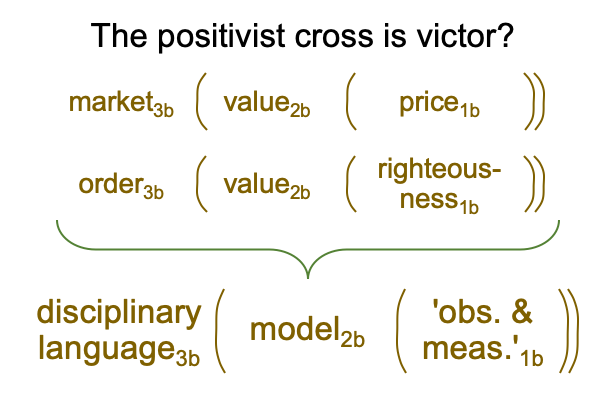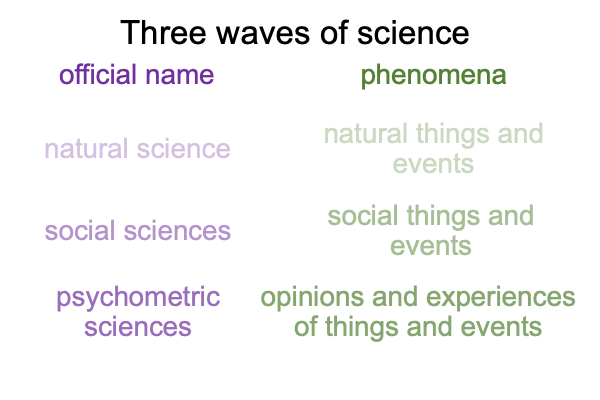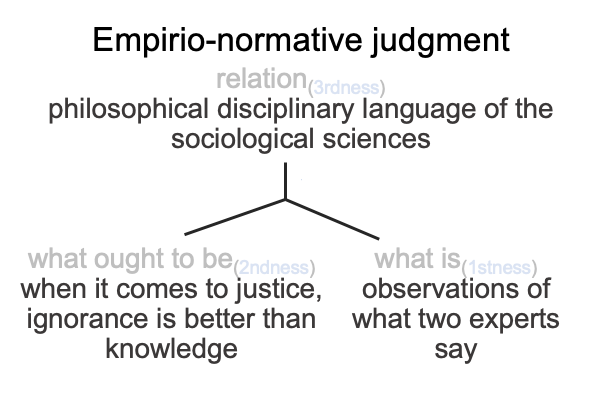Looking at Steve Fuller’s Book (2020) “A Player’s Guide to the Post-Truth Condition” (Part 9 of 26)
0078 Let me dwell on two points (A and B).
0079 First (A), the post-truth condition, as we currently experience it, involves a frustrating inability of the expert to situate the scrappy player. The situation level finds it difficult to virtually situate the content level.
One of the reasons comes from the structure of the questionable box of capitalism. Two elements are not included, because these two elements assume the box without question (and that assumption is, of course, questionable). The perspective-level actuality of success2c turns out to be the sign-vehicle (SVi) and the content-level actuality of what people say2a turns out to be the sign-object (SOi) of an interventional sign-relation, which the most upside-down sign-relation that one can imagine.
0080 Interventional and specifying sign-relations are discussed in Razie Mah’s blogs at the end of 2023 and the start of 2024, starting in earnest with Looking at John Deely’s Book (2010) “Semiotic Animal” (October 2023) and Looking atDaniel Dennett’s Book (2017) “From Bacteria, To Bach and Back” (December 2023). Two commentaries that may be of interest are Comments on Sasha Newell’s Article (2018) “The Affectiveness of Symbols” and Comments on Michael Tomasello’s Arc of Inquiry (1999-2019) by Razie Mah, available at smashwords and other e-book venues.
0081 If the post-truth condition is working appropriately, then capitalist experts3b on the situation-level can say how price1b (SIs) reflects various opinions2a (SVs) in the normal context of a market3b (SIs). The assertion (SOs) is perceived as value2b. The easily recognized specifying sign-relation says, “Opinions2a (SVs) stand for value2b (SOs) in regards to the specification of price1b within an open (unregulated) market3b (SIs).”
But, experts3b are not looking at all opinions2a. They observe and measure only a small selection of opinions2a. In particular, they register only those opinions2a that are relevant to building a model of value2b. They call the relevant opinions, “phenomena2a“.
0082 An exemplar sign-relation follows the specifying sign-relation. Expertise-acknowledged value2b (SVe) is placed into perspective by the capitalist one3c operating on the possibilities inherent in opportunity1c (SIe), resulting in capital formation or destruction2c (SOe). Value2b (SVe) stands for success or failure2c (SOe) in regards to a capitalist3coperating on the basis of opportunity1c (SIe).
Success or failure2c entails a judgment about whether the organization has capital or not, and what to do about it.
0083 Here is a picture of the capitalist box of the post-truth condition operating at face value. Expertsb virtually emerge from (and situate) what people think2a and explicitly model value2b. Then, expert valuations2b are contextualized as opportunities1c by those3c with capital2c.
A specifying sign-relation feeds into an exemplar sign-relation.

0084 Second (B), even though the interscope for socialism and capitalism look very similar, the expert level is significantly different. Order3b (the potential underlying the state) is and is not like a market3b. Righteousness1b (the potential underlying an institution within the state) is and is not like price1b. Finally, value2b does not arise from the potential of price1b. Instead, value2b arises from the potential of righteousness1b.

0085 Now I wonder, does success2c for the socialist one3c remain the same as capital2c?
I suppose that depends on how one defines the word, “capital”.
Reframing of the word, “capital”, occurs in all ongoing post-truth global projects, as seen in Comments on Daniel Estulin’s Book (2021) “2045 Global Projects At War”. A promo for this commentary appears in Razie Mah’s blog for the latter half of January 2023.

























